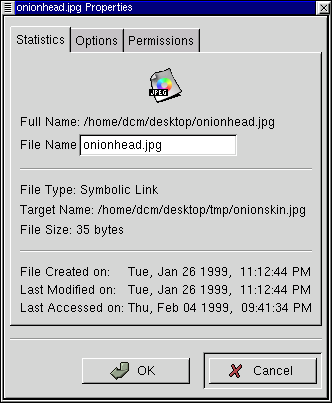File Properties and Actions
For any file in the main file display you may right mouse click on it and choose a variety of properties and actions for it from the pop-up menu:
Open - This will open the file with the default application associated with it. You may read more about editing these associations in the section called GNOME Mime Types in Chapter 17.
Open With - You may open a file with any application using this menu item. You may read more about this in the section called Launching Applications From the GNOME File Manager.
View - This will view the file with a basic text viewer.
Edit - This will launch an editor to edit the file. The editor launched is determined by the application associated with that file type. You may read more about editing this association in the section called GNOME Mime Types in Chapter 17.
Copy - This will copy the file to the clipboard so that it can be pasted elsewhere.
Delete - This will delete the file.
Move - This will bring up the Move dialog, which will allow you to move the file. You can read more about this dialog and moving files in the section called Copying and Moving Files.
Symlink - Symlink allows you to create a symbolic link of the file you have selected in another directory. When you select Symlink you will see a dialog which allows you to type in the directory and filename that you wish to be the symbolic link to the file. This link will be a "shortcut" to the selected file.
Properties - The Properties menu item will launch the Properties dialog. The Properties dialog allows you to edit and view the properties for the selected file.
The Properties dialog consists of three tabs, Statistics, Options, and Permissions.
Figure 14-6. File Properties

Statistics - This tab will show you the file information including the name, type, size, and history. You may change the name of the file in the File Name text box.
Options - This tab will allow you to change the action options for the file. You can define how to open, view, and edit the file. If you need to open it in a terminal window you may select the Needs terminal to run checkbox.
NOTE: If you bring up the Properties dialog from an icon on the desktop you will be able to change the icon for that file in the Options tab.
Permissions - This tab allows you to change the permissions and ownership of a file if you have access to do so. You may select Read, Write, and Exec permissions for the User, Group, and Others. You may also set the UID, GID and Sticky as well as define who owns the file.